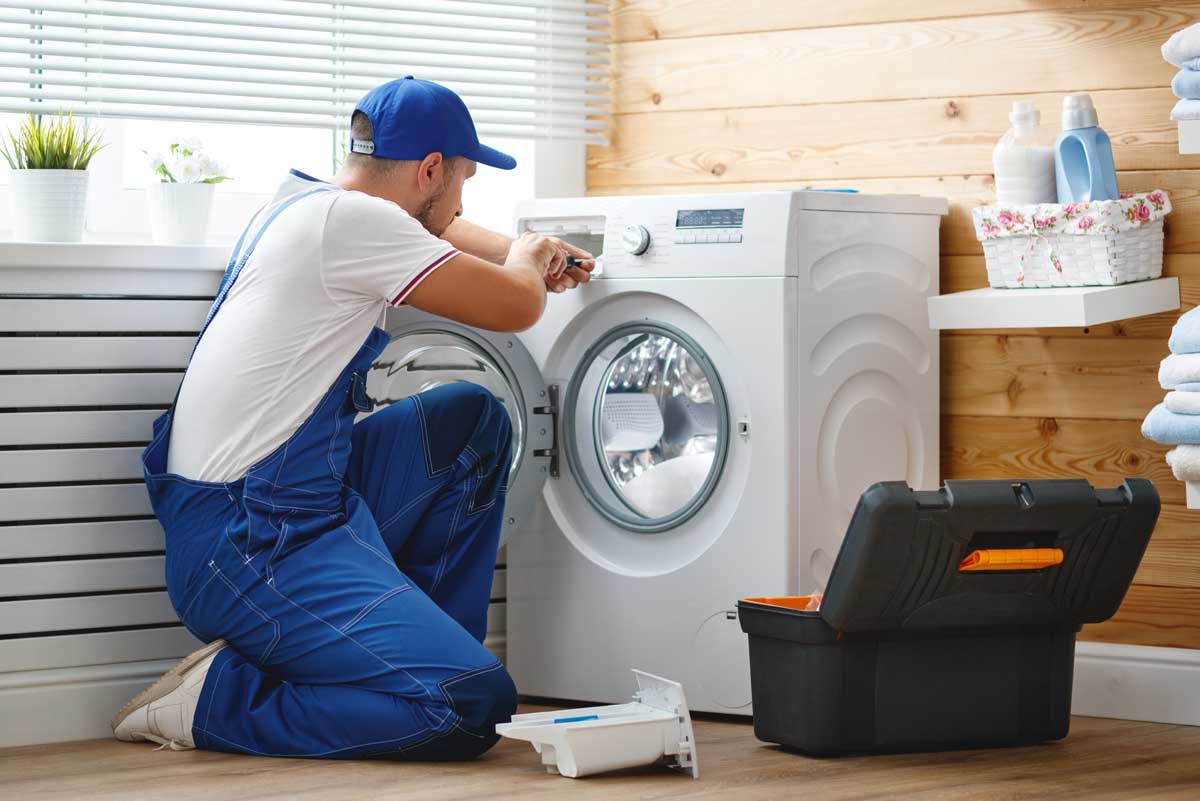DIY Appliance Repair (2024): Washing Machine, Dryer, Dishwasher, Refrigerator, Microwave, & More
When you purchase through links on our site, we may earn a commission. Here’s how it works.
Is your dishwasher in dis-repair? Have a wobbly washer? Or maybe your microwave is waving goodbye. Not to worry, we’re here to help with some useful and cost-effective ways to repair your home appliances, no tools (or experience) required. Avoid spending hundreds of dollars to hire a repair person or purchase a new appliance and learn how to fix it yourself with our tips.
Washing Machine Repair Tips

Washers save you from having to go to the laundromat. But, if you find yourself in a sudsy situation then you’re bound to bubble up with frustration.
- Not draining? When your washer isn’t draining, try cleaning or removing the pump (located in the washer’s cabinet, where it attaches to the drain hose).
- Wobbling? Wobbling should be saved for the dance floor (not the laundry room). An unbalanced machine makes the spinner off-kilter and causes it to shake and make a loud noise in the process. Try propping up the uneven side with a thin piece of plywood to level it off and prevent it from teetering back and forth.
- Leaking? A leaky machine usually means the hose is not secure or is torn. Check to ensure the washing machine is draining correctly and replace the hose if need be.
- Clogged? Other water issues include the basin not filling with water or draining completely, in which case you could have a problem with your water control, inlet valve or drain. Make sure there are no clogs that are causing the water not to flow properly.
Dishwasher Repair Tips
While the dishwasher may not be as cumbersome as not being able to do a load of laundry (hand washing dishes is a bit easier than hand washing clothes, after all), it can still put a drag into your evening if your dishwasher refuses to cooperate. Here’s some common symptoms and potential fixes.
- Not getting cleaned? It could be something as simple as food being stuck in the filter (which you should clean regularly).
- Not drying? If your dishes aren’t drying, check to make sure the heating element is working and that the drain hose has no kinks that could block it from draining all the way.
- Too many dishes? If your dishes still aren’t getting clean, you may want to try out new ways to arrange your pots and pans that may be blocking your machine from proper operating procedures. Make sure the detergent chamber is not blocked by big, bulky items next to the door and that the water spray arm (in the middle) can spin freely and do its job.
Properly maintaining your dishwasher can help avoid costly repairs. This video shows you how to easily remove and clean your dishwasher filter.
How To Remove And Clean Your Dishwasher Filter (Video)
Refrigerator Repair Tips
Refrigerators and freezers are essential to any home since they are responsible for keeping your food and leftovers fresh and your drinks cold. But from time to time they can let you down.
The most common issues with refrigerators are noises and leaks. Once you pinpoint where those are coming from you can easily diagnose.
Because they are often the largest (and most expensive) kitchen appliance, you’ll want to make sure you take good care of your fridge to make it lasts as long as possible. Refrigerators are one of the few appliances that run day and night, so more use means more wear and tear.
Refrigerator Maintenance Tip
Once or twice a year, remove the grill and sweep any dust and debris from underneath with a broom and then wipe with a warm cloth.
Dryer Repair Tips
A clothes dryer is no good if it’s not actually living up to its name and drying your clothes. Unlike dishwashers which have a number of home remedies, dryers are a little more complicated to fix.
- Not starting? If the machine is not starting it could be a simple fix of the door switch which wears out over time (especially if you have a habit of slamming the door). Either the latch is broken or it shorted out. You can replace it yourself but be sure to unplug the power source first to prevent potential electrocution.
- Clean your dryer ducts. It’s a good idea to get your dryer duct cleaned at least once a year to ensure that lint doesn’t back up and catch fire. If your duct is short and easy to get to, then you can remove and clean it yourself. There are professionals who have long hoses and special cleaning devices for longer, harder to reach ducts.
Microwave Repair Tips
So, you can’t zap your frozen meal. Not to worry, we may have your solution that will have that bean burrito warm and toasty again in no time.
- Not turning on? The issue could be your breaker. Reset the switch for your kitchen’s grid in your breaker box and see if that does the trick.
- Still not turning on? Unless your microwave is super high-tech or built-in to your range, then you’re honestly probably better off getting a replacement one (they are pretty cheap!) as the cost of a repair could easily exceed a new microwave. Most thrift stores carry tons of high-end, stainless steel microwaves that you can swap out your old one with. And it’s faster and easier than dealing with scheduling someone to come out to take a look. The labor and parts could quickly amount to more money than the value of your microwave. Either way, in the meantime, you can ask your neighbor if you can borrow their’s or heat up your food the old-fashioned way on the stovetop or in the oven.
Do You Have A Home Warranty?
All these appliance repair tips should help but if you’ve tried and your appliances still aren’t working then it may be time to call a handy person to repair or get a replacement installed.
In the future, you can save yourself money and time by having a home warranty, which can cover the costs of major appliance repairs. Find out who our recommended picks are and compare various types of plans in our home warranty provider comparison.



